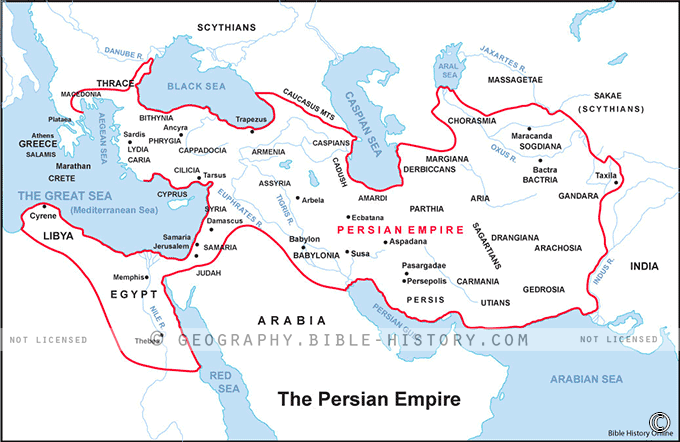
The Map of the Persian Empire is a captivating visual representation of one of history's most influential and expansive empires. Spanning three major continents and boasting a rich tapestry of cultures and histories, the Persian Empire left an indelible mark on the ancient world, and its legacy endures in contemporary societies.
The Persian Empire's Vast Territory
At its zenith, the Persian Empire, also known as the Achaemenid Empire, was the largest empire the world had ever seen. Encompassing lands that make up modern-day Iran, Iraq, Turkey, Egypt, and parts of Greece and India, it was a sprawling domain that spanned Asia, Africa, and Europe.
The Capital at Persepolis
Persepolis, located in modern-day Iran, was the grand capital of the Persian Empire. This majestic city was a testament to the empire's architectural and engineering prowess. Its palaces, gateways, and intricate carvings showcased the opulence and sophistication of the Persian civilization.
Cyrus the Great and Darius the Great
The Persian Empire owed much of its success to visionary rulers like Cyrus the Great, known for his policy of religious tolerance and humanitarian approach to conquest, and Darius the Great, who introduced a system of governance and administration that facilitated the empire's immense size.
The Royal Road and the Postal System
The empire's efficient communication and transportation systems, including the famous Royal Road and a postal service, connected distant regions. This facilitated trade, cultural exchange, and the administration of such a vast realm.
The Persian Legacy
The Persian Empire made significant contributions to art, literature, science, and governance. It played a pivotal role in the development of the Silk Road, connecting East and West. Persian culture and innovations continue to influence modern societies, from culinary traditions to architectural styles.
Enduring Historical Significance
The Persian Empire's influence extended to the realms of religion, as Zoroastrianism, the faith of many Persian rulers, played a role in shaping the religious landscape of the ancient world. The empire's conflicts with Greece, notably during the Greco-Persian Wars, are etched into history.
Exploring the Map
The Map of the Persian Empire allows us to trace the boundaries and regions that once fell under Persian rule. It invites us to contemplate the empire's complex history, its remarkable achievements, and its enduring impact on the world we live in today.
The Map of the Persian Empire is more than a geographical representation; it is a gateway to a world of history, culture, and the remarkable achievements of an ancient superpower. It serves as a reminder that the legacies of great empires continue to shape our understanding of the past and present.
Blank Topo Map of The World
Abraham’s Journey
The Captivity of Judah (586-516 B.C.)
The Fall of Judah 586 B.C.
The Northern Kingdom of Israel
The Southern Kingdom of Judah
The Divided Kingdom
The Fertile Crescent
Ur of the Chaldees
Shechem in Old Testament Times
Prophets, Kings, and Nations
Jesus Last Passover
New Testament Israel
New Testament Places
Old Testament Israel
Provinces of the Roman Empire
Israel during David’s Kingdom
David’s Kingdom
Cities of the New Testament 4
Cities of the New Testament 3
Cities of the New Testament 2
Mediterranean Sea
Cities of the New Testament
First Century Jerusalem
Empire of David and Solomon
David’s Kingdom
Israel Under Rehoboam
Ophir and Tarshish
The Period of the Kings
Ramoth Gilead
Samaria
Solomon’s Temple
Zarephath and MT Carmel
Jabesh Gilead and Tribes
Judah in the Time of David
Kingdom of Saul
Kirjath Jearim
Michmash
Mount Gilboa in the Time of David
Nob Davids Flight
Shiloh
Israel and Judah
Assyrian Empire Under Esarhaddon
Assyrian Empire Under Sennacherib
Captivity of 10 Tribes
Events in 2 Kings
The Khabur River
Israel and Syria
Captives From Judah
Kingdom of Jeroboam
Mesha’s Kingdom
Pharaoh Necho Battles King Josiah at Megiddo
Babylonian, Mede and Persian Empires
Samaria and Nearby Territories
Syria at its Height
Hebron
Mahanaim
1949 Map of Israel With Boundaries
First & Second Journeys of Paul
Journeys of the Apostles
Paul’s Third Missionary Journey
Saul’s Journey to Damascus and Arabia
Paul’s Final Visits
Paul’s 1st Missionary Journey
Paul’s 2nd Missionary Journey
Paul’s 3rd Missionary Journey
Paul’s Voyage to Rome
Phillip Journeys to Samaria and Gaza
Judah at the Time of Amos
Empire of Alexander the Great
Israel Under the Maccabees
Galilee During Maccabees
Idumea Intertestamental Period
Kingdom of the Ptolemies
Kingdom of the Seleucids
Ptolemaic Egypt Seleucid Asia
The Roman World
Kingdom of Ptolemies and Seleucids
The World During the 6TH Century BC
Mount Horeb
The Red Sea
The Exodus
Ezra’s Journey to Restore Jerusalem
Israel and Judah During Hosea’s Time
The Ancient World
Canaan During the Time of Abraham
The City of Shechem
Supposed Location of the Garden of Eden
The Land of Israel in Genesis
The Jordan River
The Kingdom of Nimrod
Mount Ararat and Mesopotamia
The Descendants
Sodom and Gomorrah
The Kingdom of Egypt
The Hamites
The Kingdom of the Hittites
Ur of the Chaldees
Judah at the Time of Haggai
Jesus Passes Through Samaria
